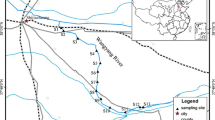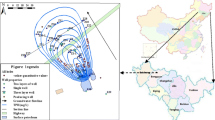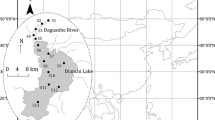Abstract
This paper has investigated the concentration and distribution of polycyclic aromatic hydrocarbons in shallow groundwater from an alluvial-diluvial fan of the Hutuo River in North China. Results show that the concentration levels of 16 priority polycyclic aromatic hydrocarbons range from 0 to 92.06 ng/L, do not conform to drinking water quality standards in China (GB 5749- 2006). However, the concentration figures of priority polycyclic aromatic hydrocarbons are much lower than that of other studies conducted elsewhere in China. In addition, highly-concentrated polycyclic aromatic hydrocarbons (50–92 ng/L) are fragmentarily distributed. The composition of polycyclic aromatic hydrocarbons from this study indicates that low molecular polycyclic aromatic hydrocarbons are predominant in groundwater samples, medium molecular compounds occur at low concentrations, and high molecular hydrocarbons are not detected. The polycyclic aromatic hydrocarbon composition in groundwater samples is basically the same as that of gaseous samples in the atmosphere in this study. Therefore, the atmospheric input is assumed to be an important source of polycyclic aromatic hydrocarbons, no less than wastewater discharge, adhesion on suspended solids, and surface water leakage. Ratios of specific polycyclic aromatic hydrocarbons demonstrate that they mainly originate from wood or coal combustion as well as natural gas and partially from petroleum according to the result of principal component analysis. On the whole, conclusions are drawn that the contamination sources of these polycyclic aromatic hydrocarbons are likely petrogenic and pyrolytic inputs. Future investigations by sampling topsoil, vadose soil, and the atmosphere can further verify aforementioned conclusions.
Similar content being viewed by others
References
Lee B C, Shimizu Y, Matsuda T, Matsui S (2005). Characterization of polycyclic aromatic hydrocarbons (PAHs) in different size fractions in deposited road particles (DRPs) from lake Biwa area, Japan. Environ Sci Technol, 39(19): 7402–7409
Cui X H, Li B H, Chen H H (2008). Contamination characteristics and pollutant sources analysis on PAHs in shallow groundwater in suburb of Taihu Plain. Environ Sci (Lisse), 29(7): 1806–1810
Doong R A, Lin Y T (2004). Characterization and distribution of polycyclic aromatic hydrocarbon contaminations in surface sediment and water from Gao-ping River, Taiwan. Water Res, 38(7): 1733–1744
Focazio M J, Kolpin DW, Barnes K K, Furlong E T, Meyer M T, Zaugg S D, Barber L B, ThurmanME (2008). A national reconnaissance for pharmaceuticals and other organic wastewater contaminants in the United States—II) Untreated drinking water sources. Sci Total Environ, 402(2–3): 201–216
Gong X Y, He Y Z, Sun Y L (2015). Distribution and source of polycyclic aromatic hydrocarbons in groundwater in the upper region of Sihu Lake Basin from Jianghan Plain. Acta Scientiae Circumstantiae, 35(3): 789–796 (in Chinese)
Grover I S, Sharma R, Singh S, Pal B (2013). Polycyclic aromatic hydrocarbons in some grounded coffee brands. Environ Monit Assess, 185(8): 6459–6463
Guo W, He M, Yang Z, Lin C, Quan X, Wang H (2007). Distribution of polycyclic aromatic hydrocarbons in water, suspended particulate matter and sediment from Daliao River watershed, China. Chemosphere, 68(1): 93–104
Jarsjö J, Bayer-Raich M, Ptak T (2005). Monitoring groundwater contamination and delineating source zones at industrial sites: uncertainty analyses using integral pumping tests. J Contam Hydrol, 79(3–4): 107–134
Jia Z C, HeWX, Qin Y (1981). Report on hydrogeological investigation on agriculture water supply (1:100,000) in the east plain in Shijiazhuang region, Hebei Province. Ninth Team of Hebei Geology Bureau, Shijiazhuang, China
Kavouras I G, Koutrakis P, Tsapakis M, Lagoudaki E, Stephanou E G, von Baer D V, Oyola P (2001). Source apportionment of urban particulate aliphatic and polynuclear aromatic hydrocarbons (PAHs) using multivariate methods. Environ Sci Technol, 35(11): 2288–2294
Li C (2012). Experience and assumption of canal water pollution control in Shijin Canal. Science Times, 15
Li Y S, Fei Y H, Wang Z, Qian Y, Chen J S, Zhang F E, Zhang Z J (2011). Occurrence features and leaching of chloroform in shallow groundwater. Environmental Pollution & Control, 33(7): 36–38 (in Chinese)
Li Y S, Zhang Z J, Fei Y H, Qian Y, Wang Z, Chen J S, Zhang F E (2014). Groundwater quality and contamination characteristics in the Hutuo River Plain Area, Hebei Province. Acta Geoscientica Sinica, 35(2): 169–176 (in Chinese)
Liang S X, Tang J M, Liu S, Li Z C, Wu Y H, Wang J F (2014). Assessment of water quality and biological toxicity in Wangyang Ditch. J Environ Health, 31(6): 532–534
Liang Y G, Qi R G (2009). Analysis of main problems and reasons during energy development in Shijiazhuang City. Science and Technology Innovation Herald, 18: 132
Lin Y (2014). Spatio-temporal and Human Exposure of Polycyclic Aromatic Compounds in the Atmosphere of North China. Beijing: Peking University
Liu S Z, Tao S, LiuWX, Liu Y N, Dou H, Zhao J Y,Wang L G,Wang J F, Tian Z F, Gao Y (2007). Atmospheric polycyclic aromatic hydrocarbons in North China: a winter-time study. Environ Sci Technol, 41(24): 8256–8261
Lü J G, Xu R J, Zhang Q H, Liu J Y, Liao C Y, Wei F S (2009). Primary investigation of the pollution status of polycyclic aromatic hydrocarbons (PAHs) in water and soil of Xuanwei and Fuyuan, Yunnan Province, China. Chin Sci Bull, 54(19): 3528–3535
Luo Q, Sun L, Zhang Y H (2011). Health risk assessment of polycyclic aromatic hydrocarbons in groundwater from Xihe River area, China. Journal of Agro-Environment Science, 30(5): 959–964
Mackay D, ShiuW Y, Ma K C (1992). Illustrated Handbook of Physical Chemical Properties and Environmental Fate for Organic Chemicals: Polynuclear Aromatic Hydrocarbons, Polychlorinated Dioxins and Dibenzofurans. Boca Raton: Lewis Publishers
Masih A, Saini R, Taneja A (2008). Contamination and exposure profiles of priority polycyclic aromatic hydrocarbons (PAHs) in groundwater in a semi-arid region in India. Int J Water, 4(1/2): 136–147
Motelay-Massei A, Ollivon D, Garban B, Tiphagne-Larcher K, Zimmerlin I, Chevreuil M (2007). PAHs in the bulk atmospheric deposition of the Seine river basin: source identification and apportionment by ratios, multivariate statistical techniques and scanning electron microscopy. Chemosphere, 67(2): 312–321
Park S U, Kim J G, Jeong M J, Song B J (2011). Source identification of atmospheric polycyclic aromatic hydrocarbons in industrial complex using diagnostic ratios and multivariate factor analysis. Arch Environ ContamToxicol, 60(4): 576–589
Quesada S, Tena A, Guillén D, Ginebreda A, Vericat D, Martínez E, Navarro-Ortega A, Batalla R J, Barceló D (2014). Dynamics of suspended sediment borne persistent organic pollutants in a large regulated Mediterranean river (Ebro, NE Spain). Sci Total Environ, 473–474: 381–390
Saba B, Hashmi I, Awan M A, Nasir H, Khan S J (2012). Distribution, toxicity level, and concentration of polycyclic aromatic hydrocarbons (PAHs) in surface soil and groundwater of Rawalpindi, Pakistan. Desalination Water Treat, 49(1–3): 240–247
Shao Y X, Wang Y X, Xu X Q, Wu X, Jiang Z, He S S, Qian K (2014). Occurrence and source apportionment of PAHs in highly vulnerable karst system. Sci Total Environ, 490: 153–160
Simcik M F, Eisenreich S J, Lioy P J (1999). Source apportionment and source/sink relationships of PAHs in the coastal atmosphere of Chicago and Lake Michigan. Atmos Environ, 33(30): 5071–5079
Vilanova R M, Fernández P, Martínez C, Grimalt J O (2001). Polycyclic aromatic hydrocarbons in remote mountain lake waters. Water Res, 35(16): 3916–3926
Wen D G, Lin L J, Sun J C, Zhang Z J, Jiang Y H, Ye N J, Fei Y H, Qian Y, Gong J S, Zhou X, Zhang Y X (2012). Groundwater quality and contamination assessment in the main plains of eastern China. Earth Science—Journal of China University of Geosciences, 37(2): 220–228
Yang D, Qi S, Zhang Y, Xing X, Liu H, Qu C, Liu J, Li F (2013). Levels, sources and potential risks of polycyclic aromatic hydrocarbons (PAHs) in multimedia environment along the Jinjiang River mainstream to Quanzhou Bay, China. MarPollut Bull, 76(1–2): 298–306
Yunker M B, Macdonald R W, Vingarzan R, Mitchell R H, Goyette D, Sylvestre S (2002). PAHs in the Fraser River basin: a critical appraisal of PAH ratios as indicators of PAH source and composition. Org Geochem, 33(4): 489–515
Zakaria M P, Takada H, Tsutsumi S, Ohno K, Yamada J, Kouno E, Kumata H (2002). Distribution of polycyclic aromatic hydrocarbons (PAHs) in rivers and estuaries in Malaysia: a widespread input of petrogenic PAHs. Environ Sci Technol, 36(9): 1907–1918
Zhang B, Yang J, Zhao X Y, Sun Z W (2015). Analysis for the Cause of atmospheric contamination in Shijiazhuang City. Resources Economization & Environmental Protection, 7: 125–126 (in Chinese)
Zhang J, Yang J C,Wang R Q, Hou H, Du XM, Fan S K, Liu J S, Dai J L (2013). Effects of pollution sources and soil properties on distribution of polycyclic aromatic hydrocarbons and risk assessment. Sci Total Environ, 463–464: 1–10
Zhang W H, Wei C H, Chai X S, He J Y, Cai Y, Ren M, Yan B, Peng P A, Fu J M (2012). The behaviors and fate of polycyclic aromatic hydrocarbons (PAHs) in a coking wastewater treatment plant. Chemosphere, 88(2): 174–182
Zhang W W (2016). Pollution Characteristic and Sources of Organic Compounds in the Atmospherical Particles in Shijiazhuang. Dissertation for master degree. Hebei: Hebei University of Science and Technology
Zhang Y J, Zhu S Q, Xiao R (2007). Study on distribution of PAHs in groundwater in irrigation area along the Hunhe River in Liaoning Province. Research of Environmental Sciences, 20(1): 7–11
Zhang Z, Huang J, Yu G, Hong H (2004). Occurrence of PAHs, PCBs and organochlorine pesticides in the Tonghui River of Beijing, China. Environ Pollut, 130(2): 249–261
Zhang Z H, Shen Z L, Xue Y Q, Ren H F, Shi D H, Yin Z Z, Zhong Z S, Sun X H, Tang M H, Xie C H, Fan P F, Guo Y H, Wu J C, Zeng J H, Sun J C, Zhang C Y, Zhang Y X, Liu W S, Yang J Y (2000). The evolution of groundwater environment in North China Plain. Beijing: Geological Publishing House
Zuo Q, Duan Y, Yang Y, Wang X, Tao S (2007). Source apportionment of polycyclic aromatic hydrocarbons in surface soil in Tianjin, China. Environ Pollut, 147(2): 303–310
Acknowledgements
The authors would like to extend acknowledgement to reviewers and the associate editor for their comments and thorough review of the manuscript. This research was supported by the China Geological Survey Grant (121201106000150006), Key Laboratory of Groundwater Remediation of Hebei Province and China Geological Survey.
Author information
Authors and Affiliations
Corresponding author
Rights and permissions
About this article
Cite this article
Wang, J., Zhao, Y., Sun, J. et al. The distribution and sources of polycyclic aromatic hydrocarbons in shallow groundwater from an alluvial-diluvial fan of the Hutuo River in North China. Front. Earth Sci. 13, 33–42 (2019). https://doi.org/10.1007/s11707-018-0701-4
Received:
Accepted:
Published:
Issue Date:
DOI: https://doi.org/10.1007/s11707-018-0701-4




